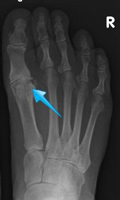Stiff Big Toe (Hallux Rigidus)

This is a degenerative condition affecting the big toe (hallux) metatarsophalangeal (MTP) joint at the base of the toe. It results in pain and restriction of movement (rigidus). The changes in the joint are essentially those of osteoarthritis, with loss of cartilage, formation of osteophytes at the joint margin (spurs) and changes in the bone (hardening or sclerosis). The lining of the joint can become inflamed (synovitis), and the ligaments holding the joint together become thicker and stiffer.
The treatment of Hallux Rigidus is similar to treatment of osteoarthritis elsewhere in the body, such as in the knee. Unfortunately, there is no cure! The aim is to improve the symptoms (pain) and to improve function.
First line non-operative treatment is with simple analgesics, anti-inflammatory medication and activity/shoe wear modification. Typically an orthotic with a big-toe extension (Morton's extension) is prescribed to reduce joint movement. If non-operative treatment fails, there are several surgical options:
Cheilectomy/Debridement
This is the surgical removal of the spurs and loose bodies from within the joint. It is generally agreed that this is only useful in early disease. It may be used in more advanced cases, but it has a much lower success rate. If the pain is thought to be simply from the 'spur' rubbing in shoes, it can be very effective. It may even improve the range of movement of the joint. The underlying disease process may progress and require a conversion to an arthrodesis or arthroplasty in time. It is a relatively simple procedure with no need for postoperative immobilisation.
Osteotomy
This is a procedure where the metatarsal bone or the phalanx (or both) is cut to shorten or re-orient the joint surface. It is typically fixed back into place with a screw or fine-wire. It is usually combined with removal of the spurs. It may also be combined with capsular interposition. It may improve the range of movement. There is no high-level medical evidence for the efficacy of this procedure, but it may be useful in some circumstances.
Arthrodesis/Fusion
This procedure involves fusing the big toe MTP joint in a functional position, using screws and/or plates. It is considered by many to be the gold standard procedure for moderate to severe disease. The main disadvantage is that there is no motion at the big toe MTP joint, but the toe can still move at the adjacent joints, and generally results in good or excellent pain relief and function in most patients. It is at this point in time the only procedure with high level evidence to support its use. Most people with a big toe MTPJ fusion don’t have a limp after the recovery period.
Arthroplasty
This means that the joint is augmented or replaced with a synthetic implant or the patients own tissue.
Synthetic implants have generally had a poor reputation because of a high failure rate in the mid to long term. Silicone or silastic implants maintain some joint movement but may loosen over time and can incite an inflammatory response within the bone, leading to bone loss, making conversion to arthrodesis difficult. There are some advances in this area in recent years, with new materials, but again it will be some time before we have long term results.
Capsular interposition is a procedure where the capsule (membrane) from around the big toe MTP joint is used to fill the joint space after removal of spurs and debridement (cleanout). It is an alternative to arthrodesis in advanced disease, and the main advantage is maintenance of some range of movement. The reported results are variable, and pain relief is generally not as reliably achieved compared to arthrodesis/fusion.









